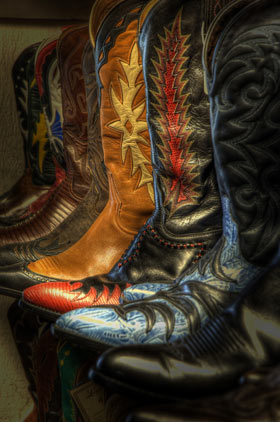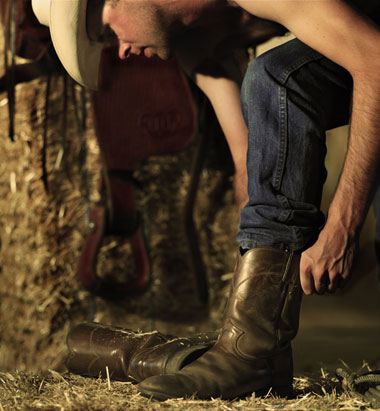Cowboy boots from the "Wild West Store" in Wimberley, Texas; photo by Dave Wilson / DaveWilsonPhotography on Flickr (noncommercial use permitted with attribution / no derivative works)
Official State Footwear of Texas
Texas designated the cowboy boot as the official state footwear in May, 2007 (the cowboy hat was also recognized as a state symbol in 2015). All Cultural Heritage Symbols
The cowboy boot was recognized as a symbol of Texas thanks to the efforts of Social Studies teacher Kay Pechacek and her 7th grade students at Bleyl Middle School in Cypress-Fairbanks ISD in Houston, Texas:
"I taught Texas history and official state symbols each year and the students always asked why the cowboy boot was not part of the list. I honestly did not know the answer - I told them I would investigate the process but that they would need to provide the research as to why the cowboy boot would be considered unique to Texas.
I contacted my state representative, Dwayne Bohac, and asked him for his help. Since I do not live in the same congressional district as the students, this was also used as a teachable moment - students realized that your representative was elected based on where you live!
The students provided research about the cowboy boot and its importance to the cattle kingdom era, significant boot makers such as Justin and Lucchese, and the impact of the cowboy boot on Texas culture today.
This information was submitted to Dwayne Bohac and his office then began the process. We submitted it as "The Official State Shoe" (that is what the students decided), but the House of Representatives revised the title to be "The Official State Footwear." The proposition was then sent to the Senate ... where it was almost killed ... but with the help of Senator Dan Patrick HCR 151 the bill was finally passed! It was a year-long process and students really experienced the political process of how a bill becomes a law ... the kids loved it!. The project was topped off with a visit to Austin to meet the governor."
- Kay Pechacek
CONCURRENT RESOLUTION No. 151
WHEREAS, The State of Texas boasts a richly diverse cultural heritage, and through the years it has adopted a number of tangible representations of that heritage as official symbols; and
WHEREAS, For nearly a century, the cowboy boot has enjoyed a special status as one of the most treasured of Texas icons; and
WHEREAS, Although riding boots date back for centuries, and although ranches first appeared in Texas during the Spanish colonial era, the basic pattern of the cowboy boot was forged in the crucible of the post-Civil War trail drives; between 1866 and 1890, mounted cowboys drove millions of head of Texas cattle to northern and western markets along such famous trails as the Chisholm, Western, and Goodnight-Loving; and
WHEREAS, Boot makers in Texas and Kansas responded to suggestions from those cowboys regarding the design of their footwear, and a slimmer boot with a higher heel, more rounded toe, and rounded, reinforced instep began to be developed; and
WHEREAS, During the course of the 20th century, cowboy boots gained a mass appeal that ultimately extended to foreign lands; this popularity was driven by an enthusiasm for the West that was fostered in the 1920s and 1930s by radio shows and movie serials and in the post-World War II decades by rodeos and dude ranches; the public's fascination with cowboys and their apparel has also been fired by movie screen idols such as Tom Mix, by entertainers such as Gene Autry, Roy Rogers, and Dale Evans, and, in recent years, by movies such as Urban Cowboy and Silverado; and
WHEREAS, The lore of the cowboy boot is replete with the names of Texas boot makers who have contributed to the emergence of that boot as a distinct type, as well as to the continuing development of their craft; one of the most influential of the early boot makers was H. J. "Big Daddy Joe" Justin, who set up a boot repair shop in Spanish Fort, just off the Chisholm Trail in Montague County, in 1879; within a decade, Mr. Justin became one of the first to offer cowboy boots by mail order; and
WHEREAS, Other Texas boot makers whose businesses gained national prominence were Mr. Justin's daughter, Enid Justin Steltzer, who established the Nocona Boot Company in Nocona in 1925, Sam Lucchese, who founded the Lucchese Boot and Shoe Factory in San Antonio in 1883, and Tony Lama, who began with a shoe repair shop in El Paso in 1912; and
WHEREAS, Smaller establishments also hold an honored place in the annals of the cowboy boot; in 2002, more than 100 cowboy-boot makers were plying their trade in this state, many of them revered by connoisseurs who were willing to wait for periods of a year or more for a custom pair; these artisans were making boots for everyone from working cowboys to sports and entertainment celebrities and heads of state; and
WHEREAS, While they hew to a basic form, cowboy boots have evolved into an amazingly versatile article; fashioned with a variety of toe and heel styles, types of leather, and embellishment, they can be worn today on virtually any occasion; so remarkable has been their diversity that they have been the subject of several coffee-table books and at least two exhibitions: "These Boots Are Made for Gawking," at the Grace Museum in Abilene, and "Heels and Toes and Everything Goes: Cowboy Boots As Art," at the Panhandle-Plains Historical Museum in Canyon; and
WHEREAS, An integral part of cowboy gear, cowboy boots played a valued role in one of the defining chapters in Texas history and continue to figure in the mythic romance of the Lone Star State; now, therefore, be it
RESOLVED, That the 80th Legislature of the State of Texas hereby designate the cowboy boot as the official State Footwear of Texas.
Source: Kay Pechacek, Coordinator, Middle School Social Studies, Cypress Fairbanks I.S.D., ISC South, Houston TX


